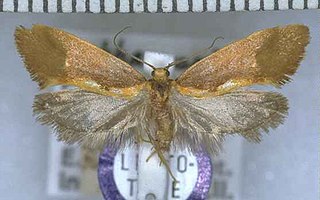Related Research Articles
Excommatica is a monotypic moth genus in the family Gelechiidae erected by Anthonie Johannes Theodorus Janse in 1951. Its only species, Excommatica compsotoma, was first described by Edward Meyrick in 1921. It is found in Mozambique and Zimbabwe.
Furcaphora is a genus of moths in the family Gelechiidae. It contains the species Furcaphora caelata, which is found in South Africa.
Panicotricha is a monotypic moth genus in the family Gelechiidae. Its only species, Panicotricha prographa, is found in South Africa. Both the genus and species were first described by Edward Meyrick in 1913.
Plagiocrossa is a monotypic moth genus in the family Lecithoceridae erected by Anthonie Johannes Theodorus Janse in 1954. Its only species, Plagiocrossa picrodora, was first described by Edward Meyrick in 1913. It is found in South Africa.

Zealandopterix zonodoxa is a moth of the family Micropterigidae. It endemic to New Zealand and is found from the Hawkes Bay north as well as on Poor Knights, Little Barrier and Great Barrier Islands. It is the smallest micropterigid in New Zealand and the shiny white markings on the forewing of this species are variable. It is a day flying moth, but has been collected using UV light. Adults are on the wing from September to March and the species has been witnessed visiting the flowers of Nikau and Cordyline pumilio in large numbers. It inhabits a wide variety of moist indigenous forest but is associated with forests in which podocarps are common. Larvae have been sieved from rotten wood on the floor of a mixed podocarp/broadleaf forest or extracted from moss or from bryophytes.

Ypsolopha nemorella is a moth of the family Ypsolophidae. It is found in northern and central Europe, mid-eastern China and Russia.
Ceromitia benedicta is a species of moth of the family Adelidae. It was first described in 1918 by Edward Meyrick and is known from South Africa.
Brenthia pleiadopa is a species of moth of the family Choreutidae first described by Edward Meyrick in 1921. It is found in Magude, Mozambique.

Pyroderces aellotricha, also known as the Cosmet moth, is a moth of the family Cosmopterigidae. It is found in New Zealand, in Australia and the Cook Islands.

Stathmopoda skelloni, the yellow featherfoot, is a species of moth in the Stathmopodidae family. It is endemic to New Zealand and can be found throughout the country. This species inhabits native forest, coastal dunes and shrubland as well as cultivated gardens and orchards. The larvae of this species feed on a variety of plant species including agricultural crops such as kiwifruit and persimmons. The adult moths are on the wing from September until March and are nocturnal but are attracted to light.

Elachista helonoma is a species of moth in the family Elachistidae. This species is endemic to New Zealand. It is classified as "At Risk, Relict'" by the Department of Conservation.
Aeolotrocha generosa is a species of moth in the family Gelechiidae. It was described by Edward Meyrick in 1921. It is found in South Africa.
Dicranucha albicincta is a moth of the family Gelechiidae. It was described by Edward Meyrick in 1921. It is found in South Africa.
Eridachtha crossogramma is a moth in the family Lecithoceridae. It was described by Edward Meyrick in 1921. It is found in Zimbabwe.

Tingena apanthes is a species of moth in the family Oecophoridae. It is endemic to New Zealand and found in the North Island. The adults are on the wing from October to December. It appears associated with Leptospermum species and it has been hypothesised that the appearance of the adults of this species imitates faded Leptospermum leaves.

Tingena hemimochla is a species of moth in the family Oecophoridae. It is endemic to New Zealand and has been observed in the North Island. Adults of this species are on the wing from December until March.

Tingena horaea is a species of moth in the family Oecophoridae. It is endemic to New Zealand and have been observed in both the North and South Islands. The adults are on the wing in January.

Tingena letharga is a species of moth in the family Oecophoridae. It is endemic to New Zealand and has been observed in Otago. Adults are on the wing in December and January.

Tingena phegophylla is a species of moth in the family Oecophoridae. It is endemic to New Zealand and has been observed in the southern parts of the South Island. This species inhabits native beech forest. The adults of this species are on the wing in December.

Trachypepla photinella is a moth of the family Oecophoridae first described by Edward Meyrick in 1883. It is endemic to New Zealand and has been collected in Wellington, Wainuiomata, D'Urville Island and Christchurch. The preferred habitat of this species is native forest and adults are on the wing from December until February.
References
- ↑ funet.fi
- ↑ Afro Moths
- ↑ Meyrick, E. (July 14, 1921). "Descriptions of South African Micro-Lepidoptera". Annals of the Transvaal Museum. 8 (2): 106 – via Biodiversity Heritage Library.
 This article incorporates text from this source, which is in the public domain .
This article incorporates text from this source, which is in the public domain .